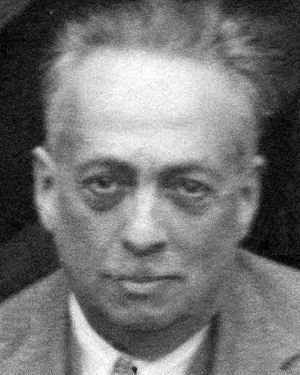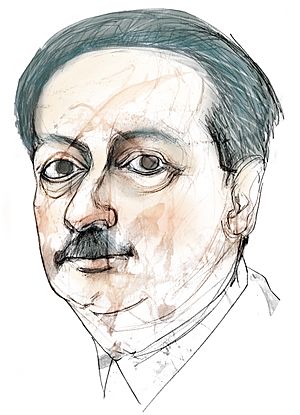Blas Cabrera facts for kids
Quick facts for kids
Blas Cabrera
|
|
|---|---|

Cabrera in 1934
|
|
| Born |
Blas Cabrera y Felipe
20 May 1878 Arrecife, Lanzarote, Spain
|
| Died | 1 August 1945 (aged 67) Mexico City, Mexico
|
| Alma mater | Universidad Central de Madrid |
| Scientific career | |
| Fields | Physics, magnetism |
| Institutions | Spanish Royal Academy of Sciences, French Academy of Sciences Royal Spanish Academy, Menéndez Pelayo International University |
| Doctoral advisor | Santiago Ramón y Cajal |
| Seat I of the Real Academia Española | |
| In office 26 January 1936 – 1 August 1945 |
|
| Preceded by | Santiago Ramón y Cajal |
| Succeeded by | Gerardo Diego |
Blas Cabrera y Felipe (born May 20, 1878 – died August 1, 1945) was an important Spanish physicist. He was a pioneer in studying how materials behave with magnetism. Many people see him as one of Spain's greatest scientists. He also helped start the study of physical sciences in his home country.
Contents
Blas Cabrera's Early Life and Education
Blas Cabrera was born in Arrecife, Lanzarote, Spain. He finished high school in San Cristóbal de La Laguna on the island of Tenerife. After that, he moved to Madrid.
At first, he planned to study law, following his family's tradition. However, he met a famous scientist named Santiago Ramón y Cajal. Ramón y Cajal convinced him to change his path and study science instead. Cabrera then went to the Complutense University of Madrid. He earned degrees in Physics and Mathematics. In 1901, he completed his doctorate in Physics.
Becoming a Leading Physicist
Cabrera was an experimental physicist. This means he learned by doing experiments. He was very interested in the magnetic properties of different materials. His work made him a well-known physicist of his time.
In 1903, he helped create the Spanish Society of Physics and Chemistry. He also helped start the scientific journals for this society. By 1905, he became a professor of Electricity and Magnetism at the Universidad Central. He married María Sánchez Real in 1909.
Building a Research Center
In 1910, a group called the Junta de Ampliación de Estudios created the Laboratorio de Investigaciones Físicas (Laboratory of Physical Research). Cabrera was chosen to be its director. This laboratory was very important for physics in Spain. It focused on several areas, including magnetochemistry and electrochemistry.
In 1912, Cabrera received a grant to visit research centers in Europe. He went to places like the Physics Laboratory of the ETH Zurich in Switzerland. There, he did experiments on magnetochemistry. He also visited universities in Geneva and Heidelberg, and the International Bureau of Weights and Measures in Paris.
When he returned to Spain, Cabrera used the new techniques he learned. He continued his research on magnetism with other scientists.
Cabrera's Scientific Discoveries
Blas Cabrera was a very productive researcher. Between 1910 and 1934, he published about 110 scientific papers. His work on magnetism was highly respected. For example, he explained how materials become magnetized. He also improved a scientific rule called Curie-Weiss's law. This law describes how magnetic materials behave at different temperatures.
He also made many improvements to experimental equipment. He was the first scientist in Spain to use advanced math methods. These methods helped him find very precise values for physical constants. Some of his measurements of magnetic properties are still considered very accurate today.
Sharing New Ideas
Cabrera didn't just do research. He also helped spread new ideas about physics. In the early 1900s, many new theories were being developed. In 1912, he wrote an article about "Fundamental principles of vectorial analysis." This article, along with another review, helped introduce special theory of relativity to Spain. This was a very important new idea in physics.
International Recognition and Leadership
Cabrera's work was recognized all over the world. In 1923, he hosted Albert Einstein during Einstein's visit to Spain. In 1928, Cabrera became a member of the French Academy of Sciences. Famous physicists like Paul Langevin and Maurice de Broglie supported his membership.
That same year, he received a great honor. At the suggestion of Einstein and Marie Curie, Cabrera was invited to join the Scientific Committee of the 6th Solvay Conference. These conferences brought together the world's best physicists every few years. At the 1930 Solvay Conference, Cabrera gave a presentation on "The magnetic properties of matter."
Leading Scientific Institutions
In 1931, Cabrera became the director of the Universidad Central de Madrid. A year later, he helped create the National Institute of Physics and Chemistry. This was done with help from the Rockefeller Foundation. Today, another research institute stands in that building.
In 1931, Cabrera also joined the International Bureau of Weights and Measures. This organization sets standards for measurements. In 1933, he helped create the Summer International University of Santander. He became its director the next year.
Later Life and Exile
In 1936, the Spanish Civil War began. Cabrera was in Santander at the time. He moved to Madrid, which was controlled by the Republican side. In 1937, he became the secretary of the International Bureau of Weights and Measures in Paris. He lived there until 1941.
After the war ended, the new Spanish government asked him to leave his position. Cabrera resigned and moved to Mexico. There, he became a professor of Atomic Physics and History of Physics at the Universidad Nacional Autónoma de México. In 1944, he started directing a science magazine called Ciencia. He also published his last work, El magnetismo de la materia (The Magnetism of Matter). Blas Cabrera died in Mexico in 1945.
Important Roles and Memberships
Blas Cabrera held many important positions and was part of many groups:
- Member and president of the Real Academia de Ciencias Exactas, Físicas y Naturales (Royal Academy of Exact, Physical and Natural Sciences).
- Member of the Real Academia Española (Royal Spanish Academy), taking the seat of his teacher Santiago Ramón y Cajal.
- President of the Sociedad Española de Física y Química (Spanish Society of Physics and Chemistry).
- Director of the Laboratory of Physics Investigations.
- Director of the Instituto Nacional de Física y Química (National Institute of Physics and Chemistry).
- Foreign member of the French Academy of Sciences.
- Member of the Scientific Committee of the 6th Solvay Conference in 1930.
- Director of the Universidad Central de Madrid and the Universidad Internacional Menéndez Pelayo.
- Secretary of the International Bureau of Weights and Measures in Paris.
- Member of the committee for the Society of Friends of André-Marie Ampère, which created the first interactive science museum in France.
Works by Blas Cabrera
- La teoria de los magnetones y la magnetoquímica de los compuestos férricos (1912) - About magnetons and the magnetochemistry of iron compounds.
- Principios fundamentales de análisis vectorial en el espacio de tres dimensiones y en el Universo de Minkowski (1912-13) - Fundamental principles of vector analysis in 3D space and Minkowski Universe.
- ¿Qué es la electricidad? (1917) - What is electricity?
- MagnétoChimie (1918) - Magnetochemistry.
- Principio de relatividad (1923) - Principle of relativity.
- El átomo y sus propiedades electromagnéticas (1927) - The atom and its electromagnetic properties.
- Electricidad y teoría de la materia (1933) - Electricity and theory of matter.
- El magnetismo de la materia (1944) - The magnetism of matter.
See also
 In Spanish: Blas Cabrera para niños
In Spanish: Blas Cabrera para niños



